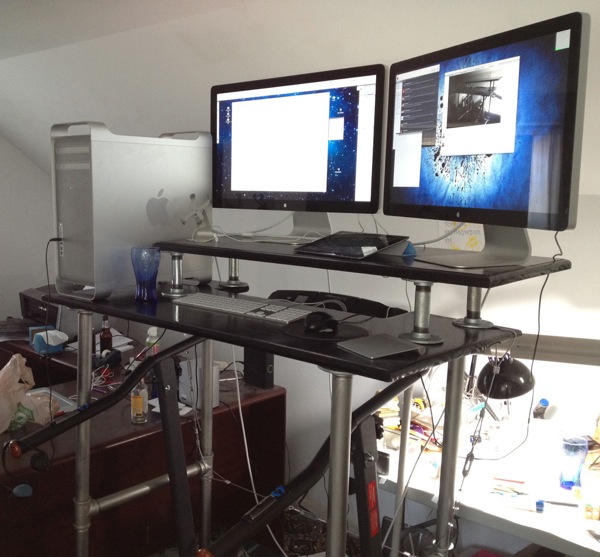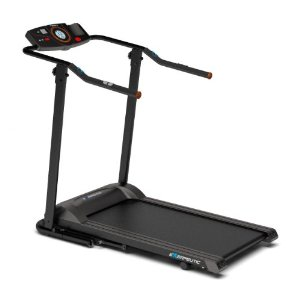I've been steadily putting on weight and getting in worse shape since before the dot com boom. Since we started MartianCraft, I've had very few days off, and my average work day has been probably twelve hours, possibly longer. Every time I try and get into a routine of exercising, something happens: a client emergency, a deadline, a build, a new prospective client, a minor family emergency. When there's not enough hours in the day (and there never are), the exercise was always the first thing to get cut.
Recently, I came across this brilliantly simple idea from a Mayo Clinic cardiologist. It's called the Treadmill Desk. Essentially, you replace your chair with a treadmill, and instead of trying to get a good strenuous calorie-burning bout of exercise in a few times a week, you just walk while you're working. You don't walk fast; in fact, you go quite slow. They typically recommend that you walk between one and two miles per hour, which is about half of most people's normal walking speed. This speed allows you to function fairly normally. After just a few minutes, you can type and mouse normally. If it gets hard to type, you back off on the speed a little. It's not a race. It's not even exercise in the traditional sense.
I'm typing this blog post while walking on a treadmill.
The goal with this walking is not to break a sweat, but rather to just be in constant motion. You will want your office a touch cooler than normal, though, as even slow walking does raise your body temperature. Despite the low-key nature of the movement, a typical person burns an additional 100 - 130 calories per hour they're at their desk. For a typical person working an eight hour day, that's between 800 and 1040 calories per day. If you work longer hours or weigh more than the average person, it's even more calories. Now, think about that. You have to burn approximately 3500 calories to lose a pound of weight, so assuming you don't increase your caloric intake, that's about a pound every three to four days of work, or two pounds a week. For someone working a forty hour week, that's about five pounds a month, or sixty pounds a year without additional exercise or dieting. There's a lot of health benefits that go along with losing extra weight, also. Lower blood pressure, lower cholesterol, lower incidence of several types of cancer.
If you work more than forty hours a week, the benefits can be even greater, assuming you don't eat more to make up for the extra calories you burn.
I've talked to a number of people who are using treadmill desks, and the feedback was universally positive. Everybody lost weight – several of them a considerable amount – and all were in better health than when they started. And almost everyone said the following word-for-word phrase to me: "I would never go back to a normal desk".
After about the third person gave me the same basic story, I was sold. Sign me up! I can do this.
But there was a problem.
There are lots of plans for treadmill desks around the Internet and you can actually buy treadmill desks now. But, here's the thing: My primary machine is a Mac Pro with two 27" ACD monitors along with a crap-ton of accessories. I couldn't find any desk for under $5,000 that looked sturdy enough to safely and securely hold the weight of all my gear, and all the plans I found for building one seemed to assume the use of a laptop or small computer with small monitor.
Because of that big sheet of glass, Apple's monitors are heavy. Because of that big aluminum case, the Mac Pro is also very heavy. My computer and monitors alone weigh well over a hundred pounds, and I wasn't about to trust that much weight worth that much money to something that looked flimsy or was designed to hold a laptop.
I experimented for a week using a makeshift treadmill desk with my MacBook Air, and I found the walking and working quite easy to do, but also found myself constantly pining to move back to my desk to use my more powerful machine and bigger monitors. I usually abandoned the treadmill after about two hours when I'd start getting into more hardcore coding, not because of the treadmill, but because of the computer.
But, that week was enough to convince me that this was a good way to reverse the slow but persistent upward trend in my weight that's marked the last several years of my life. Unfortunately, it also convinced me that I could only make it work if I could find a way to use my computer while walking.
So, I decided to build my own desk. Building a sturdy desk this tall (over four feet tall in my case, since I'm 6'3" and will be standing on a treadmill desk that's about 6" high) turned out to be an interesting, but not-entirely-trivial engineering exercise. It took a couple of re-designs and a lot of swearing, but my desk is now done and I've been happily using it for a couple of days now.
Here's my rig on my desk (excuse the messy office):

After I've been using it for longer and am convinced the design is good, I'll share how I made the desk for anyone who might wish to build one for themselves.
So far, so good, though. The desk seems to be solid, has no perceptible wobble, and the monitors and computer don't seem to be putting any noticeable strain on it. Yesterday, I walked nearly nine miles at an average of 1.6 mile per hour and had a productive work day. Today's about half over and I've burned a little over 600 calories while fixing two pretty gnarly bugs in client apps. These two days have been enough to convince me that this is going to work.
By having my good computer on the treadmill desk and my MacBook Air at my regular desk, there's a built-in incentive for me to walk, or at least stand, rather than sit at my desk. I'm simply more productive when I have more screen real estate and a more powerful computer.
In a week or so, I'll put together a parts list and basic instructions, but the design is pretty basic. 1¼" galvanized pipe makes up the main frame of the desk with ⅛" wire rope and turnbuckles as guy wires to provide additional lateral stability.
This is the treadmill I use:

It's designed only for walking, will hold up to 400 pounds, and it's shorter than most treadmills, so it takes up less room. It's not cheap, but it's fairly reasonable for a treadmill at $400, and it can fold up out of the way if you need to. I've been very happy with it so far. While it's not whisper quiet, it's nowhere near as loud as most treadmills I've used, and it has a full set of controls on the handle where you can reach them easily while using it as part of a treadmill desk, which is much nicer than having to awkwardly reach over the desk to the treadmill's console.
The desk plans (when I post them them) are intended to work with this treadmill, you will probably need to make minor adjustments to use it with other models, as well as account for any height difference.








No comments:
Post a Comment